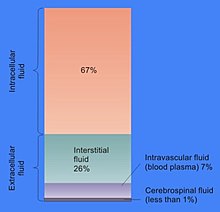Body fluid
This article aboutbiologymay beexcessively human-centric. |

Body fluids,bodily fluids,orbiofluids,sometimesbody liquids,areliquidswithin thebodyof an organism.[1]In lean healthy adult men, the totalbody wateris about 60% (60–67%) of the totalbody weight;it is usually slightly lower in women (52–55%).[2][3]The exact percentage of fluid relative to body weight is inversely proportional to the percentage of body fat. A lean 70 kg (150 lb) man, for example, has about 42 (42–47) liters of water in his body.
The total body of water is divided intofluid compartments,[1]between theintracellular fluidcompartment (also called space, or volume) and theextracellular fluid(ECF) compartment (space, volume) in a two-to-one ratio: 28 (28–32) liters are inside cells and 14 (14–15) liters are outside cells.
The ECF compartment is divided into theinterstitial fluidvolume – the fluid outside both the cells and the blood vessels – and theintravascularvolume (also called the vascular volume andblood plasmavolume) – the fluid inside the blood vessels – in a three-to-one ratio: the interstitial fluid volume is about 12 liters; the vascular volume is about 4 liters.
The interstitial fluid compartment is divided into thelymphatic fluidcompartment – about 2/3, or 8 (6–10) liters, and thetranscellular fluidcompartment (the remaining 1/3, or about 4 liters).[4]
The vascular volume is divided into thevenousvolume and thearterialvolume; and the arterial volume has a conceptually useful but unmeasurable subcompartment called theeffective arterial blood volume.[5]
Compartments by location
[edit]- intracellular fluid(ICF), which consist ofcytosoland fluids in thecell nucleus[6]
- Extracellular fluid
- Intravascular fluid(blood plasma)
- Interstitial fluid
- Lymphatic fluid(sometimes included in interstitial fluid)
- Transcellular fluid
Health
[edit]Clinical samples
[edit]Clinical samples are generally defined as non-infectious human or animal materials includingblood,saliva,excreta,body tissueandtissue fluids,and alsoFDA-approved pharmaceuticalsthat areblood products.[7]In medical contexts, it is a specimen taken fordiagnostic examinationor evaluation, and for identification ofdiseaseor condition.[8]
See also
[edit]- Basic reproduction number
- Blood-borne diseases
- Clinical pathology
- Humorism
- Hygiene
- Ritual cleanliness
References
[edit]- ^ab"body fluid".Taber's online – Taber's medical dictionary.Archivedfrom the original on 2021-06-21.Retrieved2021-06-22.
- ^"The water in you".Howard Perlman.December 2016.
- ^Lote, Christopher J.Principles of Renal Physiology, 5th edition.Springer. p. 2.
- ^Santambrogio, Laura (2018). "The Lymphatic Fluid".International Review of Cell and Molecular Biology.337:111–133.doi:10.1016/bs.ircmb.2017.12.002.ISBN9780128151952.PMID29551158.
- ^Vesely, David L (2013). "Natriuretic Hormones".Seldin and Giebisch's the Kidney:1241–1281.doi:10.1016/B978-0-12-381462-3.00037-9.ISBN9780123814623.
- ^Liachovitzky, Carlos (2015)."Human Anatomy and Physiology Preparatory Course"(pdf).CUNY Bronx Community College.CUNY Academic Works. p. 69.Archivedfrom the original on 2017-08-23.Retrieved2021-06-22.
- ^Packaging Guidelines for Clinical Samples- Retrieved 7 August 2014.
- ^specimen- The Free Dictionary. Retrieved 7 August 2014
Further reading
[edit]- Paul Spinrad. (1999)The RE/Search Guide to Bodily Fluids.Juno Books.ISBN1-890451-04-5
- John Bourke. (1891)Scatalogic Rites of All Nations.Washington, D.C.: W.H. Lowdermilk.
External links
[edit]- De Luca LA, Menani JV, Johnson AK (2014).Neurobiology of Body Fluid Homeostasis: Transduction and Integration.Boca Raton: CRC Press/Taylor & Francis.ISBN9781466506930.
